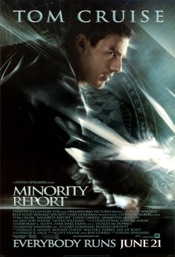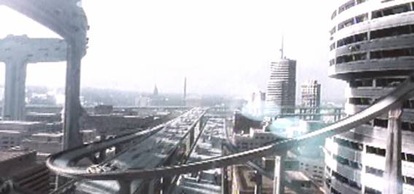The Black & White of Free-Will

By: Dominick A. Leone
Minority
Report
Written by
Scott Frank
Directed by Steven Spielberg
Minority Report is an oddly
misplaced mystery/action movie about a cop who is
accused of a future murder. Set in early
21st
century
Washington, DC, the police have the ability to stop
murders before they happen with the help of three
psychics. They use technology to enhance the visions of
these psychics, referred to as pre-cognitives (or
“pre-cogs”) to generate not only the name of the victim
and perpetrator, but also the evidence against them:
hence the crime of murder is reduced to a black and
white picture. Anytime the Pre-cogs’ visions are in
conflict a Minority Report is generated, yet it is also
destroyed except for what the pre-cog who predicted it
remembers deep within their mind.
John Anderton is the Chief-of-Police of PreCrime, a
department of the police that deals with murder and
uses pre-cogs. His son was kidnapped, driving him to
PreCrime, and preventing further loss of innocent life.
His faith in the system is rooted his loss, and up to
his accusation, unfaltering. His faith begins to falter
when he discovers that there is missing data regarding
some of the victims and perpetrators. This leads him to
question the system, which eventually leads those in
charge to arrange for his arrest for the future murder
of Jim Crow. Convinced of his own innocence, and the
infallibility of the PreCrime system, looks for
evidence that he was framed, only to confront the
choice of murdering a man (Jim Crow) that seems to have
kidnapped and killed his son.
The over-riding theme in Minority
Report is the
interplay between predestination and choice: do we have
a choice in our destiny? This question is one with not
only a religious undertone, but a moral one. Is there
an alternative future for one forecasted to commit
murder? What if you knew your future was murder? With
John we have a person who is committed to upholding the
law, and we should expect that he would not murder
someone – especially if he had previous knowledge that
he was to commit it. Yet by the end of the movie we
learn that there is no minority report for him. He is
destined to kill Crow. His choice is to arrest him for
the kidnap and murder of his son, thereby restoring
justice and creating his own future.
Human fallibility is the weakness of any system we
create. The failings of PreCrime originate from the
failings not of the Pre-Cogs, but of the humans that
run PreCrime. The system ignored all minority reports,
and because it orchestrated the results from the
Pre-Cogs, was susceptible to tampering. Although we
prefer to believe that the police are “the good guys”,
the truth is that they are human – susceptible to their
own faults and demons. John is only human, and after
the profound loss of his son, turns to drugs to escape
from reality. His wife, Laura, divorces him because she
needed to escape from the memories of her son that John
conjured for her. Lemar Burgess, the Director of
PreCrime, is also a man drawn into crime by his desire
to keep PreCrime from being discredited. In the end he
is willing to kill to keep his power, a most human
fallacy. Gideon, the sentry at PreCrime, questions John
about removing a data file when he is challenged on his
own righteousness.

The Cinematography of Minority Report lends itself to the theme of black and white. The lighting is done in a very interesting manner: outside is always bright and overwhelmed with sunlight while inside scenes are dark with light streaming into the scene from outside. This leads one to think that maybe Steven Spielberg believes that we are basically dark on the inside, and it is the outside influences that keep us in the light (good). In the world of PreCrime, there is only the victim and perpetrator: BLACK & White. Even the costumes are mostly black and white with occasional washed out color. Most of the characters wear black – especially those associated with PreCrime – but the innocent such as the children wear white. When John is exercising in the “Sprawl” (the high crime area), he gets drugs from a dealer, and his face is shadowed. Here we see that even Chief Anderton has a darkside.
In a world dominated by black and white versions of right and wrong, innocence and guilt, we are all blind.
“In the
Land of the Blind, the one-eyed man is king”